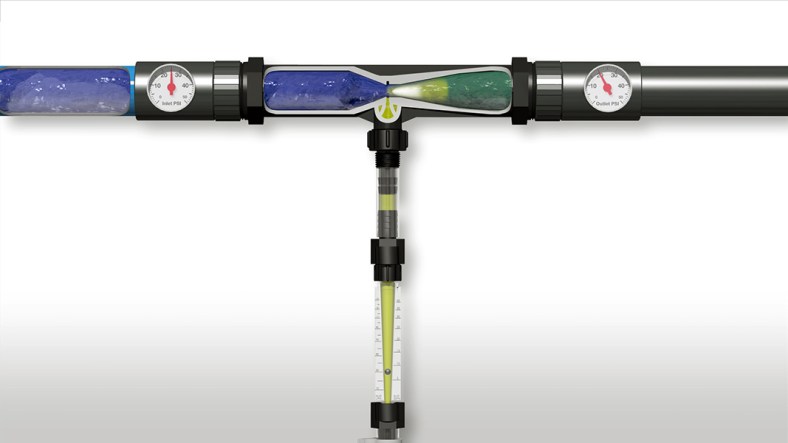Accurate mixing systems are vital in urban ag systems to maintain
productivity and profitability. [Photo: Mazzei Injector Company]
By Jim Lauria, Mazzei Injector Company
In indoor crop production systems, water is vital for crop growth, handy for delivering nutrients and other inputs…and a major cost. As a result, managing every drop of water—and every ounce it carries, whether it’s a biodynamic compost tea or a conventional crop protection product—is critical to maintaining a healthy bottom line.
As closed-system farms become ever more precise, their owners are assessing their choices with an eye toward maximizing precision and efficiency. That has led many to struggle to choose between water-run pumps and venturi injectors for dosing and mixing inputs into their water.
Comparing Technologies
Both water-run pumps and venturi injectors operate on long-established technologies. Water-run pumps use pressure from irrigation flow to lift an injector piston, drawing in a known dose of fertilizer or chemical before it is forced back down by a spring and delivers the dose into a sealed chamber. Injection rates are calculated as a ratio to the flow of irrigation
water through the main line.
Venturi injectors use line pressure to constrict flowing water in a conical inlet chamber, then release it into a cone-shaped outlet port. As the flow expands in the outlet port, it creates a vacuum that draws in nutrients, chemicals or air and mixes it thoroughly. Injection in venturi systems is measured in percentages, parts per million, or gallons per acre.
While water-run pumps require regular replacement of seals and springs, venturi injectors contain no moving parts, so there is minimal wear and virtually no maintenance. The difference is apparent in both acquisition cost and maintenance cost, says John Petrosso, agriculture sales engineer for Mazzei Injector Company.

air—into irrigation water precisely and efficiently.
“A greenhouse can put in four pumps with a manifold, or they can put in venturis for the cost of the rebuild kits the pump manufacturers recommend buying every 12 months,” he explains. He adds that venturi injectors may be specified in sizes ranging from 0.5 inches to four inches, allowing growers to precisely size their venturi injection system to their needs.
Petrosso points out that venturi injectors blend injected materials more evenly than pumps do—a huge advantage in improving precision and reducing physical footprint.
“With a pump, every time that piston goes up, it’s sending out a pulse, where with a venturi you have a more homogeneous mixture that’s going out into that irrigation system,” he explains. “That’s why you’ll also see that water-run pumps usually require a mixing chamber or static mixer. It’s also why pumps can be incompatible with biological products like compost teas or microbial pesticides—the pistons can exert a lot of force and tear up microbes.”
Aeration Excitement
One of the most exciting applications of injection systems is aerating the crop root zone. Petrosso says a recent study at the Center for Irrigation Technology at California State University, Fresno and Memorial University of Newfoundland, Canada, suggested that AirJection® improved nitrogen use efficiency, lowered the potential for NOx production, and created an aerated environment that tipped the soil’s microbial population toward aerobic bacteria that correspond with crop vigor and growth.
“Most urban and indoor farms aim to set a higher standard for food quality and sustainability,” Petrosso says. “Venturi injectors take those benefits a step further as the ultimate complement to sustainable systems. They allow growers to fine-tune their input use, gently and efficiently mix even the most sensitive biological products, and they literally go with the flow, minimizing energy consumption.”


